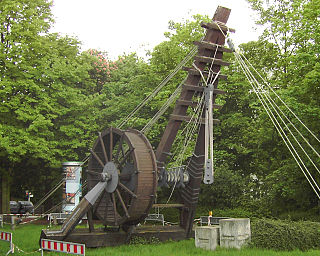
The gens Claudia, sometimes written Clodia, was one of the most prominent patrician houses at Rome. The gens traced its origin to the earliest days of the Roman Republic. The first of the Claudii to obtain the consulship was Appius Claudius Sabinus Regillensis, in 495 BC, and from that time its members frequently held the highest offices of the state, both under the Republic and in imperial times.

Lucius Neratius Marcellus was an imperial Roman military officer and senator who held a number of posts in the Emperor's service. Marcellus was elected consul twice, first under Domitian in 95 AD and again under Hadrian in 129. His life provides several examples of how patronage operated in early Imperial Rome.

Tlos is an ancient ruined Lycian hilltop citadel near the resort town of Fethiye in the Mugla Province of southern Turkey, some 4 kilometres northwest of Saklikent Gorge. Tlos is believed to be one of the most important religious Lycian sites and settlement on the site is said to have begun more than 4,000 years ago.
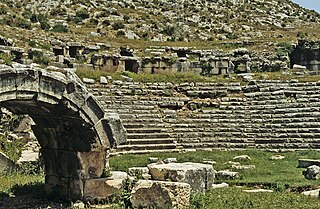
Limyra was a small city in Lycia on the southern coast of Asia Minor, on the Limyrus River, and twenty stadia from the mouth of that river.It was a prosperous city, and one of the oldest cities in lycia. The city had rich and abundant soil, and gradually became one of the finest trade settlements in Greece. Pericles adopted it as the capital of the lycian league. The city came under control of the Persian Empire after it was conquered by Cyrus the Great. He later annexed Lydia and its territories after a decisive victory at the Battle of Thymbra and the Siege of Sardis, where he defeated armies twice as large as his. Cyrus then got his greatest general: Harpagus of Media to conquer the much smaller kingdoms in Anatolia, while he went to conquer the Neo-Babylonian Empire. Anatolia would become an important place for the Persian monarchs who succeeded Cyrus. The massive Royal road constructed by Darius went from the Persian capital of Persepolis, to the Anatolian city of Sardis. Limyra would stay under Persian control until the very end of its days, when it was conquered and sacked by Alexander the Great.
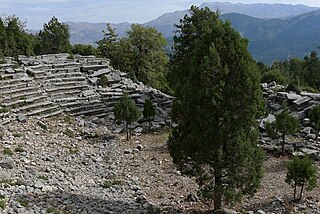
Oenoanda or Oinoanda was an ancient Greek city in Lycia, in the upper valley of the River Xanthus. It is noted for the philosophical inscription by the Epicurean, Diogenes of Oenoanda. The ruins of the city lie west of the modern village İncealiler in the Fethiye district of Muğla Province, Turkey, which partly overlies the ancient site.

The Bridge near Limyra is a late Roman bridge in Lycia, in modern south-west Turkey, and one of the oldest segmented arch bridges in the world. Located near the ancient city of Limyra, it is the largest civil engineering structure of antiquity in the region, spanning the Alakır Çayı river over a length of 360 m (1,181.1 ft) on 26 segmental arches. These arches, with a span-to-rise ratio of 5.3:1, give the bridge an unusually flat profile, and were unsurpassed as an architectural achievement until the late Middle Ages. Today, the structure is largely buried by river sediments and surrounded by greenhouses. Despite its unique features, the bridge remains relatively unknown, and only in the 1970s did researchers from the Istanbul branch of the German Archaeological Institute carry out field examinations on the site.
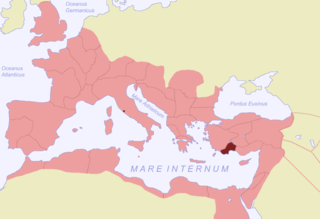
Lycia et Pamphylia was the name of a province of the Roman empire, located in southern Anatolia. It was created by the emperor Vespasian, who merged Lycia and Pamphylia into a single administrative unit. In 43 AD, the emperor Claudius had annexed Lycia. Pamphylia had been a part of the province of Galatia.

The tribute penny was the coin that was shown to Jesus when he made his famous speech "Render unto Caesar..." The phrase comes from the King James Version of the gospel account: Jesus is asked, "Is it lawful to give tribute to Caesar, or not?" and he replies, "bring me a penny, that I may see it".
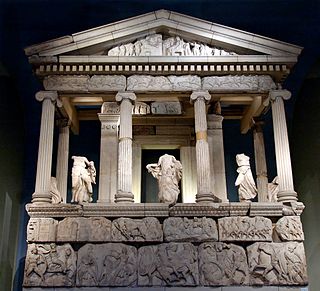
The Nereid Monument is a sculptured tomb from Xanthos in Lycia, close to present-day Fethiye in Mugla Province, Turkey. It took the form of a Greek temple on top of a base decorated with sculpted friezes, and is thought to have been built in the early fourth century BC as a tomb for Arbinas, the Xanthian dynast who ruled western Lycia under the Achaemenid Empire.
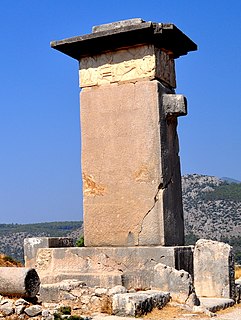
The Harpy Tomb is a marble chamber from a pillar tomb that stands in the abandoned city of Xanthos, capital of ancient Lycia, a region of southwestern Anatolia in what is now Turkey. Built in the Persian Achaemenid Empire, and dating to approximately 480–470 BC, the chamber topped a tall pillar and was decorated with marble panels carved in bas-relief. The tomb was built for an Iranian prince or governor of Xanthus, perhaps Kybernis.
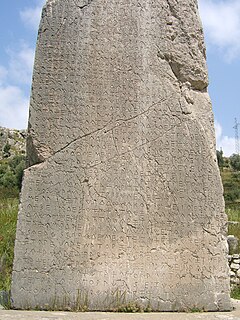
The Xanthian Obelisk, also known as the Xanthos or Xanthus Stele, the Xanthos or Xanthus Bilingual, the Inscribed Pillar of Xanthos or Xanthus, the Harpagus Stele, the Pillar of Kherei and the Columna Xanthiaca, is a stele bearing an inscription currently believed to be trilingual, found on the acropolis of the ancient Lycian city of Xanthos, or Xanthus, near the modern town of Kınık in southern Turkey. It was created when Lycia was part of the Persian Achaemenid Empire, and dates in all likelihood to ca. 400 BC. The pillar is seemingly a funerary marker of a dynastic satrap of Achaemenid Lycia. The dynast in question is mentioned of the stele, but his name had been mostly defaced in the several places where he is mentioned: he could be Kherei (Xerei) or more probably his predecessor Kheriga.
Balbura was a Lycian town, the site of which is at Çölkayiği. The acropolis hill is about 90 metres above the plain of Katara, and the plain is 1,500 feet (460 m) above the level of the sea. The ruins occupy a considerable space on both sides of the stream. There are two theatres at Balbura; one is on the south side of the acropolis hill, and the other is in a hollow in the front of the mountain on the south side of the stream: the hollow in the mountain formed the cavea. There are also remains of several temples at Katara; and of Christian churches. The ethnic name Βαλβουρεύς occurs on two inscriptions at least at Katara. The site was discovered by Hoskyn and Forbes. Balbura was part of a district called Cabalia, named Cabalis by Strabo with two other cities, Bubon and Oenoanda.
Bubon was a city of ancient Lycia noted by Stephanus of Byzantium; the ethnic name, he adds, ought to be Βουβώνιος, but it is Βουβωνεύς, for the Lycians rejoice in this form. The truth of this observation of Stephanus is proved by the inscription found on the spot: Βουβωνέων ἡ Βουλὴ καὶ ὁ Δῆμος. Bubon is placed in the map in Spratt's Lycia, near 37° N. lat. west of Balbura, near a place named Ibecik. Bubon is mentioned by Pliny, Ptolemy, and Hierocles. Pliny mentions a kind of chalk (creta) that was found about Bubon. The city stood on a hill side. The ruins are not striking. There is a small theatre built of sandstone, and on the summit of the hill was the acropolis. Bubon is in a mountainous tract and it commands the entrance to the pass over the mountains. Bubon, along with Balbura and Oenoanda formed the district Cabalia.
Lucius Domitius Apollinaris was a Roman senator of the late first century. He is best known for his literary activities, as an acquaintance of Pliny the Younger and a patron of the poet Martial. He was appointed suffect consul in the nundinium of July-August 97 with Sextus Hermentidius Campanus as his colleague.
Marcus Hirrius Fronto Neratius Pansa was a Roman senator who held several posts in the emperor's service. He was appointed suffect consul in either AD 73 or 74. Pansa is known primarily through epigraphic inscriptions.





















